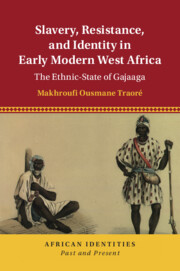Book contents
- Slavery, Resistance, and Identity in Early Modern West Africa
- African Identities: Past and Present
- Slavery, Resistance, and Identity in Early Modern West Africa
- Copyright page
- Contents
- Figures
- Tables
- Preface
- Acknowledgement
- Introduction
- Part I Between the Sahara and the Atlantic Ocean
- 1 The Ethnic State of Gajaaga
- 2 African Slavery versus the Slave Trade(s)
- Part II Atlantic Slavery, Kingship, and Worship of Nature
- Part III Gajaaga at the Center, the French Empire at the Edges
- Conclusion
- Bibliography
- Index
1 - The Ethnic State of Gajaaga
from Part I - Between the Sahara and the Atlantic Ocean
Published online by Cambridge University Press: 16 November 2023
- Slavery, Resistance, and Identity in Early Modern West Africa
- African Identities: Past and Present
- Slavery, Resistance, and Identity in Early Modern West Africa
- Copyright page
- Contents
- Figures
- Tables
- Preface
- Acknowledgement
- Introduction
- Part I Between the Sahara and the Atlantic Ocean
- 1 The Ethnic State of Gajaaga
- 2 African Slavery versus the Slave Trade(s)
- Part II Atlantic Slavery, Kingship, and Worship of Nature
- Part III Gajaaga at the Center, the French Empire at the Edges
- Conclusion
- Bibliography
- Index
Summary
The Soninke diaspora and Ethnic State arose within the context of the trans-Saharan and trans-Atlantic slave trades. The geographical space of Gajaaga, its populations, and society are described in detail to provide the necessary context for understanding the Ethnic State of Gajaaga as both a political space and as the Soninke people’s homeland. It shows how the Soninke Ethnic State was geographically delimited by the Soninke people’s distribution, making physical and ethnic borders coterminous. The chapter also describes how Soninke society was largely controlled by an aristocracy of nobles. Primary among them were the Bacili, descendants of the founders of Gajaaga and warrior princely families, the state of Gajaaga being built through military conquest. The administrative organization, in turn, was based on a political system whose codes and structures were found in several societies throughout Upper Senegal, Upper Gambia, and the Niger Delta. This political system was both decentralized and gerontocratic, meaning the throne was handed down to the eldest members of the royal family. As a consequence, political rivalries developed between the different royal families. This rivalry, referred to as faabaremmaxu, was codified in Soninke political culture and was settled by the Kafundo, or royal assembly.
Keywords
- Type
- Chapter
- Information
- Slavery, Resistance, and Identity in Early Modern West AfricaThe Ethnic-State of Gajaaga, pp. 49 - 98Publisher: Cambridge University PressPrint publication year: 2023

